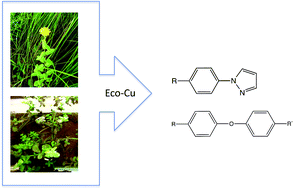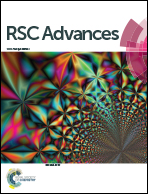Ullmann reaction through ecocatalysis: insights from bioresource and synthetic potential
Abstract
We report the elaboration of novel bio-sourced ecocatalysts for the Ullmann coupling reaction. Ecocatalysis is based on the recycling of metals issued from phytoremediation or rehabilitation, and an innovative chemical valorization of the subsequent biomass in the field of catalysis. Here, we describe efficient copper accumulation by plants via phytoextraction and rhizofiltration. These phytotechnologies were revisited to demonstrate a novel potential of these natural resources for green chemistry. Taking advantage of the remarkable ability of the selected plants to accumulate Cu(II) species into their roots or leaves, the latter can be directly used for the preparation of ecocatalysts, called Eco-Cu®. The formed Eco-Cu® catalysts are thoroughly characterized via ICP-MS, IR studies of pyridine sorption/desorption, TEM, XRD, SM and model reactions, in order to elucidate the chemical composition and catalytic activity of these new materials. Significant differences of properties and activities were observed between Eco-Cu® and conventional Cu catalysts. Eco-Cu® are highly active catalysts in Ullmann coupling reactions with lower Cu quantities compared to known copper catalysts.


 Please wait while we load your content...
Please wait while we load your content...